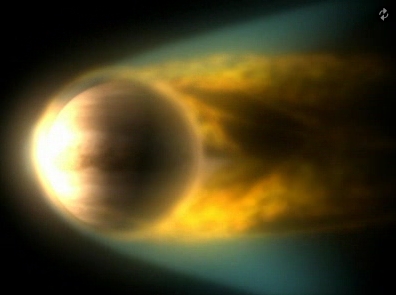[/caption]
Although it’s similar in size, Venus is very different from Earth. The temperature at the surface is hot enough to melt lead, with an atmosphere of almost pure carbon dioxide, 92 times thicker than Earth’s atmosphere. Even with this extreme environment, is it possible that there’s life on Venus?
Probably not.
Here on Earth, we find life wherever we find liquid water: kilometers deep underground, beneath glaciers, and even inside nuclear reactors. If there’s liquid water, there’s life. But there doesn’t seem to be any liquid water on Venus.
Scientists think that Venus did have liquid water billions of years ago, but a runaway greenhouse effect heated up the planet to the point that all the water evaporated, and was eventually lost to space. The atmosphere is now 96% carbon dioxide, with the rest nitrogen and a few other trace compounds.
But there’s another possibility. High up in the atmosphere of Venus, at an altitude of 50 km, the air pressure and temperature get to the point that they’re very similar to Earth. In fact, at this altitude, it’s the most Earthlike place in the whole Solar System. Some scientists think that there could be microbial life high up in the atmosphere of Venus.
Since the Sun’s solar wind is constantly blowing on Venus, and Earth is “downwind” from Venus, it’s possible that microbial life is being blown from Venus to Earth. Maybe life on Earth got its start on Venus.
You can read a longer article about the possibility of life on Venus here. And here’s a video that shows how the atmospheres of Venus and Mars leak into space.
Want more information on Venus? Here’s a link to Hubblesite’s News Releases about Venus, and here’s NASA’s Solar System Exploration Guide to Venus.
We have also recorded a whole episode of Astronomy Cast that’s just about planet Venus. Listen to it here, Episode 50: Venus.

